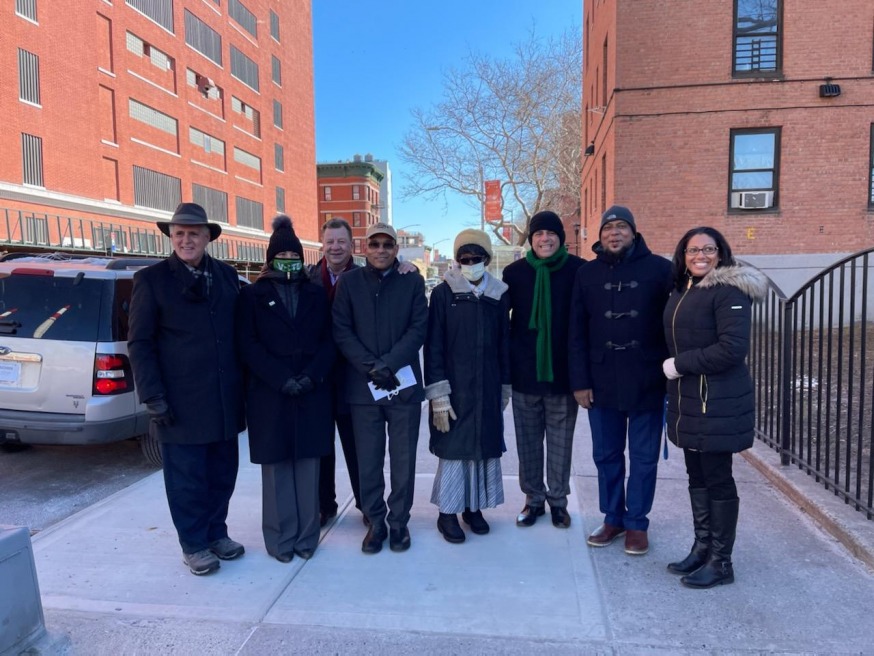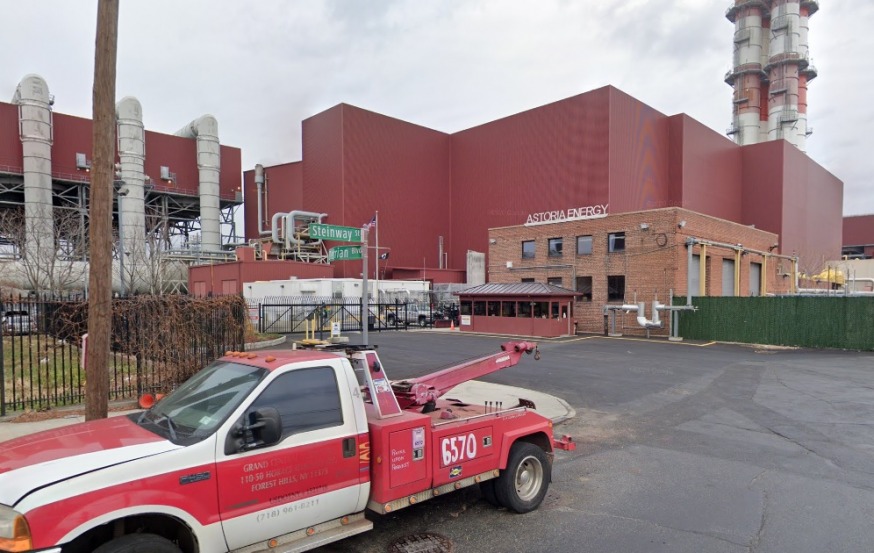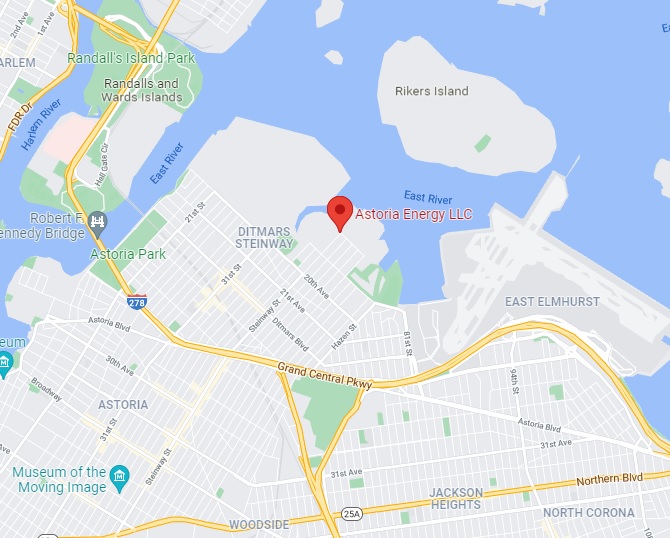
Community leaders–including Council Member James Gennaro, Bishop Mitchell Taylor and Costa Constantinides–outside Queensbridge Houses Tuesday calling on the state to approve two renewal energy projects that would lead to a reduction of fossil fuel emissions in Western Queens (Photo courtesy of Costa Constantinides)
Feb. 16, 2022 By Christian Murray
Community leaders and environmental advocates held a press conference outside the Queensbridge Houses NYCHA complex Tuesday to call on the Public Service Commission to approve two renewable energy projects that would lead to a reduction of fossil fuel burning plants in Western Queens.
The NYS Public Service Commission—which oversees and regulates the electric, gas, water and telecommunication industries—will be deciding the fate of two renewable projects in March.
The first project is called Clean Path NY, which would transmit solar and wind energy from Central New York to the Rainey Substation in Long Island City, while the second project is called the Champlain Hudson Power Express, which would send hydropower 339-miles along a transmission line from the U.S.-Canadian border to the Astoria Energy Complex.

A section of the Astoria Energy Complex, which is located at the end of Steinway Street by Luyster Creek, will be transformed into an emission free converter station as part of the Champlain Hudson Power Express transmission line upon state approval (GMaps)
The two projects have the potential to bring over 2,500 MW of renewable energy to Queens replacing the demand for fossil fuel plants and moving the city toward meeting its goals of a 70 percent clean energy grid by 2030 and a 100 percent clean energy grid by 2040, as required by the state’s Climate Leadership and Community Protection Act.
Today, New York City generates between 80 and 90 percent of its electricity via fossil fuels.
“We need to build renewable energy period,” said former council member Costa Constantinides, who organized the press conference. “The time for action is now and we can no longer wait to clean our grid. For too long, fossil fuel burning power plants have polluted our neighborhood making our families sicker increasing our asthma rates.”

The Astoria Energy complex located at the end of Steinway Street
The two projects were selected by the governor from a list of seven submitted to the New York State Energy Research and Development Authority (NYSERDA), a state public-benefit corporation that focuses on energy efficiency. The proposals involved providing power for New York City via wind, solar and hydropower—which the state has been calling for.
But the Public Service Commission must approve the projects. The commission will be closing its public comment period on Feb. 21 and its seven commissioners will render a decision sometime in March.
Constantinides said the approval is no certainty. “They can decide that the projects don’t make sense and vote them down,” he said. “They could approve one and not the other.”
He said that lobbyists—primarily from the oil and gas industries—are working to oppose them. Some will try to make the argument, he said, that the projects are too costly and will raise people’s electricity bills.
The Independent Power Producers of New York, a NYS trade group representing companies that supply power, is urging the commission to reject the Champlain Hudson Power Express project—which it is says requires expensive new transmission lines—while move forward with Clean Path NY.
“New York electricity consumers should not have to bear the staggering costs of two transmission projects,” said IPPNY President and CEO Gavin J. Donohue in a statement. “It is entirely possible that the 2040 zero emissions goal can be met at a lower cost with greater net benefits with the CPNY project, along with other zero emission technology that does not require expensive new transmission lines.”
Constantinides said that five of the seven commissioners live upstate, and he wants to make sure that they are aware of how important both projects are to the future of New York City and Western Queens.
The community leaders Tuesday said that it is imperative that steps are made to reduce the city’s dependency on fossil fuels and noted that 55 percent of the power generated in New York City comes from Western Queens, with residents of the 11101, 11102 and 11106 bearing the brunt of it.
Constantinides said that renewable power is not only cleaner but will reduce the volatility of electricity bills that are dependent on the gas markets.
Council Member James Gennaro, chair of the Environmental Protection Committee, also attended the event and backed both renewable energy projects.
“It is crucial that the state invest in renewals energy and shift away from harmful fuels—especially in Western Queens, where the asthma rates are significantly higher than other parts of the city,” Gennaro said. “I vow to take charge in this fight for a greener, more sustainable New York City.”
Meanwhile, Bishop Mitchell Taylor, CEO of Urban Upbound in Long Island City, said, “We implore NYS not to let the public housing residents here in Western Queens down. The cost to our community would be too great to measure.”
One Comment

The renewable energy projects better be reliable